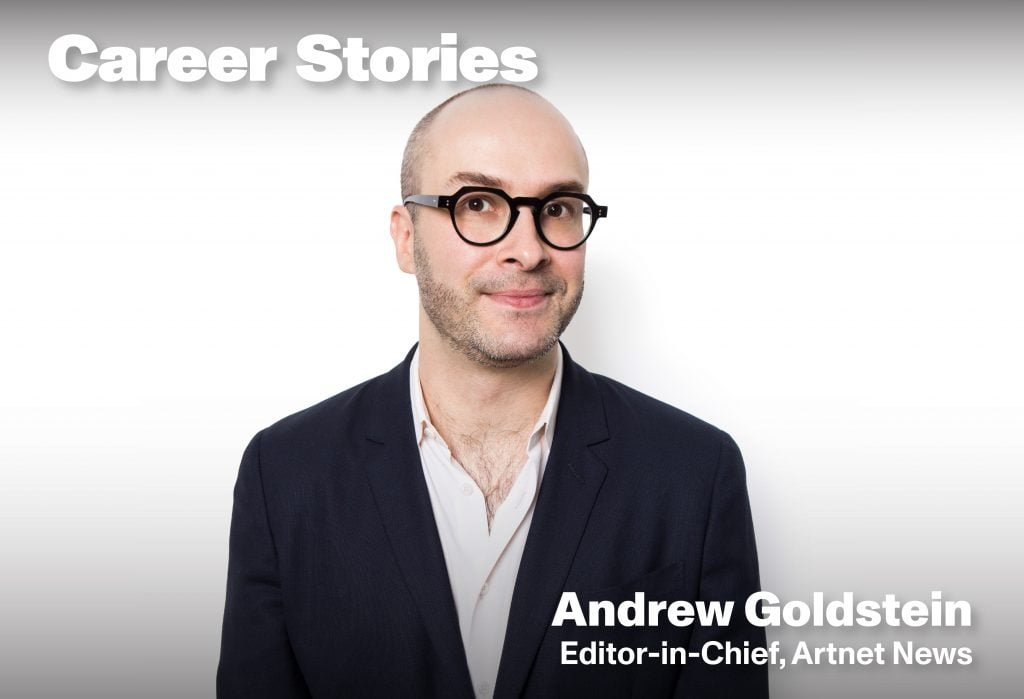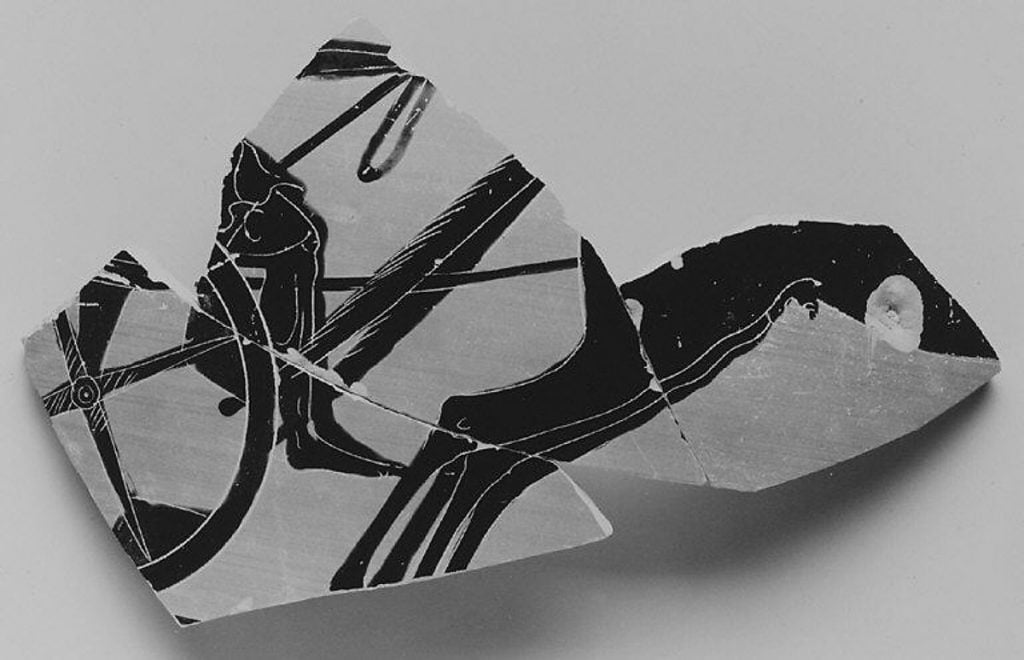Career Stories
Artnet News’s Own Editor-in-Chief Andrew Goldstein on His Picaresque Journey From Archeologist to Crime Reporter to Art Journalist
How our esteemed editor got his start.

How our esteemed editor got his start.

Samantha Baldwin

If there’s one thing that Andrew Goldstein, the editor in chief of Artnet News, has, it’s ambition. A jack of many trades, Andrew began his career as an archaeologist in Sicily before working as a crime reporter, a gossip columnist, a music writer, and, finally, an art journalist. Nowadays, he brings his ambition to Artnet, where he’s constantly concocting new and innovative ideas, including his most recent endeavor, Artnet News Pro.
When asked about his vision for the future of Artnet News, Andrew described a “360 everything omnichannel socially connected multi-platform video game TV show about art that changes the world.” Attainability aside, there’s much to be said about this editor’s creativity and drive.
Read on to learn more about Andrew’s evolving career trajectory, writing process, and the best advice his father ever gave him.
What was your first job in the art world and what is one lesson you learned from that job?
My first job in the very expanded definition of the “art world” that we at Artnet News employ was as an archeologist working on a dig at the ancient pre-Roman city of Morgantina in Sicily. Today this is best known as the find spot of the Fifth Avenue Acroliths and other looted artifacts that made their way to the Metropolitan Museum of Art’s collection and became a focal point of the restitution controversies of the 2000s. During the year I was there we didn’t have funding to actually excavate, but the interesting thing was that this wasn’t a problem—on years they had sufficient funding they would dig up artifacts like potsherds and other fancy ancient garbage, and then on years when they didn’t they would go through boxes and boxes of this stuff and figure out what it was and how it fit together, which was what I did. Once I found a fragment of a trophy from the Panathenaic Games, which was pretty cool! So I guess in addition to learning about archeology and the delights of Sicilian cuisine, I learned about the importance of being strategic with scarce resources.
You have writing published in the New York Times, New York Magazine, Rolling Stone, and various other publications. Did you always envision a career in journalism?
After the dig totally ran out of money, I came back to New York and was going to go to Columbia to take the Ph.D. route in classics, but then saw a Wall Street Journal article about a startup-politics, pop-culture, and style magazine called Radar. I sent the editor an email asking for a job as an editorial assistant (I had already done a bunch of internships in high school and college at high-gloss and ill-fated media startups like Brill’s Content and Inside.com, where I sat next to David Carr). I got a job offer and figured the ancient world wasn’t going anywhere, so why not try this out and see how it goes? Later I found out that my mom, a financial consultant specializing in magazines and alternative newsweeklies like the Village Voice, was able to give me a boost when she saw American Media’s David Pecker at a publishing event and told him I had applied for a job at Radar, where it turned out he had given some seed money.

Two fragments of a Panathenaic prize amphora similar to those which Andrew found at an archaeological dig in Morgantina, Sicily. Image courtesy of the Metropolitan Museum of Art.
Can you tell us a little bit about your career’s trajectory before you stepped into your role at Artnet News?
Radar went out of business after eight months, and I had a friend who was working as a crime reporter at the fabled City News Bureau in Chicago who complained how miserable it was in a way that sounded incredible to me. I ended up taking his job when he quit, working half a year on the daytime politics and crime beat (where I covered Barack Obama’s senate campaign), and then half a year as the overnight crime editor, working first out of police headquarters and listening to scanners for tips and then out of the very glamorous Tribune Tower.
After a year of nonstop murders and fires, Radar came back to life and I gratefully came back to New York to write a daily media and celebrity gossip column called Fresh Intelligence, where I tangled with early Gawker for scoops. When Radar went out of business again, I covered parties and events for the New York Times and New York Magazine, did some music writing for Spin and Rolling Stone, and dabbled with working (sometimes freelance) for various art-world organizations. I became the executive editor at Artinfo, where together with Julia Halperin and Ben Davis (and a pretty remarkable group of others) we built it into the biggest art news publication ever at the time, basically spawning a generation of other scoopy online art-news publications.
After two years, I jumped to Artspace (with the very kind advice of the legendary New York Times editor Arthur Gelb, my hero) to create their editorial arm and try to make a 50/50 mix of quality content and online e-commerce work better than the traditional ad model. When the company made significant changes to allow for profitability, I left Artspace and came here to Artnet!
Between writing, editing, and the behind-the-scenes work of launching Artnet Pro, how do you stay motivated?
Don’t forget hosting the Art Angle podcast, available every Friday on Apple Podcasts, Spotify, or wherever you get your podcasts! But to answer the question, I am an eternal optimist and I believe a brilliant team, hard work, ingenuity, and a long-game plan can actually build a truly successful, important, and profitable art publication. Basically, I look back at all the things that didn’t work at my various previous companies, cobble together what did work, and try my best to enable an effective operation that does truly meaningful journalism and can support my wonderful team.
Andrew hosts the Art Angle podcast, available every Friday wherever you get your podcasts.
What is your writing process like, from conception of a story to publication?
I do tons of research—much more than necessary, or advisable—then organize my notes by copying and pasting them into certain proprietary organizational formats (™), then I clean my room or do something else undesirable, because I will literally do anything I can not to write until the last possible minute. Then, kind of magically after decades of constantly writing, whatever I have to write flows out pretty much uninterrupted from the beginning to the end and I give it to someone and hope to never look at it again. I’m not sure if it’s the best process, but hey!
Since becoming editor in chief of Artnet News in 2017, what is your proudest achievement?
Bringing together the single finest team of art journalists ever assembled, without question. Everything else comes from that.
Do you have a mentor? Who inspires you?
I guess Arthur Gelb, the fabled former arts editor at the New York Times who rose to managing editor and transformed the paper from having International, National, and Metro sections to also having Arts, Dining, Home, Business, the Book Review, the magazine, etc. And then also Clay Felker, founder of New York Magazine, who I got to interview in his last days.
What advice would you give to someone trying to do what you do?
Do lots of different things, always try to surprise and delight the reader while connecting them to something of real value, have a north star and stick to it through all weather, and be very, very, very patient because creating something that never existed before is incredibly hard and takes far more time than anyone could reasonably expect.
What is the best piece of advice you have ever received?
Don’t worry so much! (My dad always told me that.)